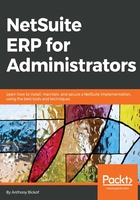
Subsidiary hierarchy
The first step is to set up the subsidiaries and subsidiary hierarchy; in other words, to determine which subsidiaries report to parent subsidiaries. This may be very simple, where all subsidiaries report to the same parent:

Subsidiary hierarchy example
Alternatively, it can be more complex, as follows:

Complex subsidiary hierarchy example
Once set up, NetSuite has the ability to report by each subsidiary inpidually (such as the UK or South Africa) or for a group of subsidiaries. A financial report for Americas, for instance, would incorporate all the transactions for all of the children of Americas, namely USA, Mexico, and Canada, and a report for the entire consolidated company would return the results for the subsidiaries.
The report would be displayed in the currency of the node or level that is being reported on, so EMEA financials are reported in € irrespective of whether all the children use €. Transactions in the UK, Switzerland, and South Africa would all be converted from their base currencies into € for the purposes of the report. In addition, the financial statements for the entire company would be reported in USD $ even though only one of the subsidiaries reports in USD $.
The currency and order of the hierarchy are therefore crucial. This group of companies should be set up differently if you need to report on the German and Swiss subsidiaries in Swiss Francs, or if South Africa reports to Americas and not EMEA. One needs to be very sure of the hierarchy before setting this up, because it is very difficult to unscramble this egg after the fact.
This demonstrates the true value of NetSuite OneWorld, in that the CFO can analyze the performance of a subsidiary or a group of subsidiaries by simply selecting that subsidiary or node in the subsidiary context field of virtually all reports. Furthermore, a transaction in South Africa in ZAR will update the Group CEO's dashboard reflected in USD $, one second after the transaction is entered into the system.
The subsidiary record is also used in streamlining operations, because it has its own logo, shipping, and return addresses, which can be placed on transaction forms; as well as subsidiary-specific preferences, such as time zone, to ensure that transactions are recorded at the correct time for auditing purposes. It also has its own tax setup to ensure that the correct local taxes are charged by the subsidiary and remitted to the appropriate tax authorities:

Subsidiary hierarchy setup in NetSuite